Characterization of Stimulatory Action on Voltage-Gated Na+ Currents Caused by Omecamtiv Mecarbil, Known to Be a Myosin Activator
Abstract
1. Introduction
2. Materials and Methods
2.1. Chemicals, Drugs, Reagents, and Solution Used in This Work
2.2. Cell Preparations
2.3. Electrophysiological Measurements with the Patch-Clamp Technique
2.4. Data Recordings and Analyses
2.5. Curve-Fitting Methods and Statistical Analyses Used in This Work
3. Results
3.1. Effect of OM on Voltage-Gated Na+ Current (INa) in Pituitary GH3 Cells
3.2. The Steady-State Current versus Voltage (I–V) Relationship and the Inactivation Curve of INa(T) Modified by the OM Presence
3.3. OM-Induced Retardation in the Cumulative Inhibition of INa(T) Inactivation during Pulse-Train (PT) Depolarizing Stimuli
3.4. Effect of OM on the Recovery Time Course in the Slow Inactivation of INa(T) Recorded from GH3 Cells
3.5. Stimulatory Effect of OM on the Window Component of INa (IN(W)) Identified from GH3 Cells
3.6. Inability of OM to Affect the Magnitude of L-Type Ca2+ Current (ICa,L) Identified in GH3 Cells
3.7. Mild Inhibition of Delayed-Rectifier K+ Current (IK(DR)) Produced by the OM Presence
3.8. Effect of OM on Depolarization-Evoked INa Identified from Neuroblastoma Neuro-2a Cells
3.9. Docking Prediction of hNaV1.7 and OM
4. Discussion
Author Contributions
Funding
Institutional Review Board Statement
Informed Consent Statement
Data Availability Statement
Acknowledgments
Conflicts of Interest
Abbreviations
| EC50 | concentration required for 50% stimulation |
| I–V | current versus voltage |
| ICa,L | L-type Ca2+ current |
| IK(DR) | delayed-rectifier K+ current |
| Hys(V) | voltage-dependent hysteresis |
| INa | voltage-gated Na+ current |
| INa(L) | late Na+ current |
| INa(T) | transient Na+ current |
| INa(W) | window Na+ current |
| NaV channel | voltage-gated Na+ channel |
| Nif | nifedipine |
| I–V relationship | current versus voltage relationship |
| OM | omecamtiv mecarbil (CK-1827452) |
| PT | pulse train |
| SEM | standard error of mean |
| τ | time constant |
| TEA | tetraethylammonium chloride |
| TTX | tetrodotoxin |
| Vramp | ramp voltage |
References
- Shen, Y.T.; Malik, F.I.; Zhao, X.; Depre, C.; Dhar, S.K.; Abarzúa, P.; Morgans, D.J.; Vatner, S.F. Improvement of cardiac function by a cardiac Myosin activator in conscious dogs with systolic heart failure. Circ. Heart Fail. 2010, 3, 522–527. [Google Scholar] [CrossRef]
- Malik, F.I.; Hartman, J.J.; Elias, K.A.; Morgan, B.P.; Rodriguez, H.; Brejc, K.; Anderson, R.L.; Sueoka, S.H.; Lee, K.H.; Finer, J.T.; et al. Cardiac myosin activation: A potential therapeutic approach for systolic heart failure. Science 2011, 331, 1439–1443. [Google Scholar] [CrossRef]
- Rhoden, A.; Schulze, T.; Pietsch, N.; Christ, T.; Hansen, A.; Eschenhagen, T. Comprehensive analyses of the inotropic compound omecamtiv mecarbil in rat and human cardiac preparations. Am. J. Physiol. Heart Circ. Physiol. 2022, 322, H373–H385. [Google Scholar] [CrossRef]
- Kumar, M.; Haghighi, K.; Koch, S.; Rubinstein, J.; Stillitano, F.; Hajjar, R.J.; Kranias, E.G.; Sadayappan, S. Myofilament Alterations Associated with Human R14del-Phospholamban Cardiomyopathy. Int. J. Mol. Sci. 2023, 24, 2675. [Google Scholar] [CrossRef]
- Liu, L.C.; Dorhout, B.; van der Meer, P.; Teerlink, J.R.; Voors, A.A. Omecamtiv mecarbil: A new cardiac myosin activator for the treatment of heart failure. Expert. Opin. Investig. Drugs 2016, 25, 117–127. [Google Scholar] [CrossRef]
- Teerlink, J.R.; Diaz, R.; Felker, G.M.; McMurray, J.J.V.; Metra, M.; Solomon, S.D.; Adams, K.F.; Anand, I.; Arias-Mendoza, A.; Biering-Sørensen, T.; et al. Cardiac Myosin Activation with Omecamtiv Mecarbil in Systolic Heart Failure. N. Engl. J. Med. 2021, 384, 105–116. [Google Scholar] [CrossRef]
- Velez, M. Advances in contemporary medical management to treat patients with heart failure. Curr. Opin. Cardiol. 2023, 38, 136–142. [Google Scholar] [CrossRef]
- Yoshikawa, T. New paradigm shift in the pharmacotherapy for heart failure-where are we now and where are we heading? J. Cardiol. 2023, 81, 26–32. [Google Scholar] [CrossRef]
- Teerlink, J.R. A novel approach to improve cardiac performance: Cardiac myosin activators. Heart Fail. Rev. 2009, 14, 289–298. [Google Scholar] [CrossRef]
- Chen, P.W.; Trivedi, A.; Lee, E.; Dutta, S.; Ahamadi, M. Population Pharmacokinetic Properties of Omecamtiv Mecarbil in Healthy Subjects and Patients with Heart Failure with Reduced Ejection Fraction. J. Cardiovasc. Pharmacol. 2022, 79, 539–548. [Google Scholar] [CrossRef]
- Vitale, M.L.; Carbajal, M.E. Involvement of myosin II in dopamine-induced reorganization of the lactotroph cell’s actin cytoskeleton. J. Histochem. Cytochem. 2004, 52, 517–527. [Google Scholar] [CrossRef]
- Yu, F.H.; Catterall, W.A. Overview of the voltage-gated sodium channel family. Genome Biol. 2003, 4, 207. [Google Scholar] [CrossRef]
- Morinville, A.; Fundin, B.; Meury, L.; Juréus, A.; Sandberg, K.; Krupp, J.; Ahmad, S.; O’Donnell, D. Distribution of the voltage-gated sodium channel Na(v)1.7 in the rat: Expression in the autonomic and endocrine systems. J. Comp. Neurol. 2007, 504, 680–689. [Google Scholar] [CrossRef]
- Catterall, W.A. Forty Years of Sodium Channels: Structure, Function, Pharmacology, and Epilepsy. Neurochem. Res. 2017, 42, 2495–2504. [Google Scholar] [CrossRef]
- Scholz, H. Mechanisms of positive inotropic effects. Basic Res. Cardiol. 1989, 84 (Suppl. S1), 3–7. [Google Scholar] [CrossRef]
- Temma, K.; Kondo, H.; Akera, T. Developmental changes in inotropic actions of neurotoxins observed in ventricular muscle of rat heart. Can. J. Physiol. Pharmacol. 1991, 69, 494–500. [Google Scholar] [CrossRef]
- Doggrell, S.; Hoey, A.; Brown, L. Ion channel modulators as potential positive inotropic compound for treatment of heart failure. Clin. Exp. Pharmacol. Physiol. 1994, 21, 833–843. [Google Scholar] [CrossRef]
- Wu, Y.; Wang, L.; Ma, J.; Song, Y.; Zhang, P.; Luo, A.; Fu, C.; Cao, Z.; Wang, X.; Shryock, J.C.; et al. Protein kinase C and Ca(2+)-calmodulin-dependent protein kinase II mediate the enlarged reverse INCX induced by ouabain-increased late sodium current in rabbit ventricular myocytes. Exp. Physiol. 2015, 100, 399–409. [Google Scholar] [CrossRef]
- MacLeod, K.T. Changes in cellular Ca(2+) and Na(+) regulation during the progression towards heart failure. J. Physiol. 2022, 598, 1339–1359. [Google Scholar] [CrossRef]
- Wu, P.M.; Cho, H.Y.; Chiang, C.W.; Chuang, T.H.; Wu, S.N.; Tu, Y.F. Characterization in Inhibitory Effectiveness of Carbamazepine in Voltage-Gated Na(+) and Erg-Mediated K(+) Currents in a Mouse Neural Crest-Derived (Neuro-2a) Cell Line. Int. J. Mol. Sci. 2022, 23, 7892. [Google Scholar] [CrossRef]
- Chang, W.T.; Wu, S.N. Characterization of Direct Perturbations on Voltage-Gated Sodium Current by Esaxerenone, a Nonsteroidal Mineralocorticoid Receptor Blocker. Biomedicines 2021, 9, 549. [Google Scholar] [CrossRef]
- Shiau, A.L.; Liao, C.S.; Tu, C.W.; Wu, S.N.; Cho, H.Y.; Yu, M.C. Characterization in Effective Stimulation on the Magnitude, Gating, Frequency Dependence, and Hysteresis of I(Na) Exerted by Picaridin (or Icaridin), a Known Insect Repellent. Int. J. Mol. Sci. 2022, 23, 9696. [Google Scholar] [CrossRef]
- Wu, S.N.; Yu, M.C. Inhibition of Voltage-Gated Na(+) Currents Exerted by KB-R7943 (2-[2-[4-(4-nitrobenzyloxy)phenyl]ethyl]isothiourea), an Inhibitor of Na(+)-Ca(2+) Exchanging Process. Int. J. Mol. Sci. 2023, 24, 1805. [Google Scholar] [CrossRef]
- Taddese, A.; Bean, B.P. Subthreshold sodium current from rapidly inactivating sodium channels drives spontaneous firing of tuberomammillary neurons. Neuron 2002, 33, 587–600. [Google Scholar] [CrossRef]
- Huang, C.W.; Hung, T.Y.; Wu, S.N. The inhibitory actions by lacosamide, a functionalized amino acid, on voltage-gated Na+ currents. Neuroscience 2015, 287, 125–136. [Google Scholar] [CrossRef]
- Nanasi, P.; Komaromi, I.; Gaburjakova, M.; Almassy, J. Omecamtiv Mecarbil: A Myosin Motor Activator Agent with Promising Clinical Performance and New in vitro Results. Curr. Med. Chem. 2018, 25, 1720–1728. [Google Scholar] [CrossRef]
- Sarno, N.; Hernandez-Clavijo, A.; Boccaccio, A.; Menini, A.; Pifferi, S. Slow Inactivation of Sodium Channels Contributes to Short-Term Adaptation in Vomeronasal Sensory Neurons. eNeuro 2022, 9, ENEURO.0471-21.2022. [Google Scholar] [CrossRef]
- Wang, J.A.; Lin, W.; Morris, T.; Banderali, U.; Juranka, P.F.; Morris, C.E. Membrane trauma and Na+ leak from Nav1.6 channels. Am. J. Physiol. Cell Physiol. 2009, 297, C823–C834. [Google Scholar] [CrossRef]
- Joos, B.; Barlow, B.M.; Morris, C.E. Calculating the Consequences of Left-Shifted Nav Channel Activity in Sick Excitable Cells. Handb. Exp. Pharmacol. 2018, 246, 401–422. [Google Scholar]
- Lo, Y.K.; Wu, S.N.; Lee, C.T.; Li, H.F.; Chiang, H.T. Characterization of action potential waveform-evoked L-type calcium currents in pituitary GH3 cells. Pflugers Arch. 2001, 442, 547–557. [Google Scholar] [CrossRef]
- Nicolas, J.; Bovee, T.F.; Kamelia, L.; Rietjens, I.M.; Hendriksen, P.J. Exploration of new functional endpoints in neuro-2a cells for the detection of the marine biotoxins saxitoxin, palytoxin and tetrodotoxin. Toxicol. Vitr. 2015, 30, 341–347. [Google Scholar] [CrossRef]
- Tan, N.N.; Tang, H.L.; Lin, G.W.; Chen, Y.H.; Lu, P.; Li, H.J.; Gao, M.M.; Zhao, Q.H.; Yi, Y.H.; Liao, W.P.; et al. Epigenetic Downregulation of Scn3a Expression by Valproate: A Possible Role in Its Anticonvulsant Activity. Mol. Neurobiol. 2017, 54, 2831–2842. [Google Scholar] [CrossRef]
- Gao, B.; Sutherland, W.; Vargas, H.M.; Qu, Y. Effects of omecamtiv mecarbil on calcium-transients and contractility in a translational canine myocyte model. Pharmacol. Res. Perspect. 2020, 8, e00656. [Google Scholar] [CrossRef]
- Abella, L.M.R.; Höhm, C.; Hofmann, B.; Gergs, U.; Neumann, J. Effects of omecamtiv mecarbil and mavacamten in isolated human atrium. Naunyn Schmiedebergs Arch. Pharmacol. 2023, 396, 499–511. [Google Scholar] [CrossRef]
- Ráduly, A.P.; Tóth, A.; Sárkány, F.; Horváth, B.; Szentandrássy, N.; Nánási, P.P.; Csanádi, Z.; Édes, I.; Papp, Z.; Borbély, A. Omecamtiv mecarbil augments cardiomyocyte contractile activity both at resting and systolic Ca(2+) levels. ESC Heart Fail. 2023, 10, 1326–1335. [Google Scholar] [CrossRef]
- Trivedi, A.; Oberoi, R.K.; Jafarinasabian, P.; Zhang, H.; Flach, S.; Abbasi, S.; Dutta, S.; Lee, E. Effect of Varying Degrees of Renal Impairment on the Pharmacokinetics of Omecamtiv Mecarbil. Clin. Pharmacokinet. 2021, 60, 1041–1048. [Google Scholar] [CrossRef]
- Horváth, B.; Szentandrássy, N.; Veress, R.; Almássy, J.; Magyar, J.; Bányász, T.; Tóth, A.; Papp, Z.; Nánási, P.P. Frequency-dependent effects of omecamtiv mecarbil on cell shortening of isolated canine ventricular cardiomyocytes. Naunyn Schmiedebergs Arch. Pharmacol. 2017, 390, 1239–1246. [Google Scholar] [CrossRef]
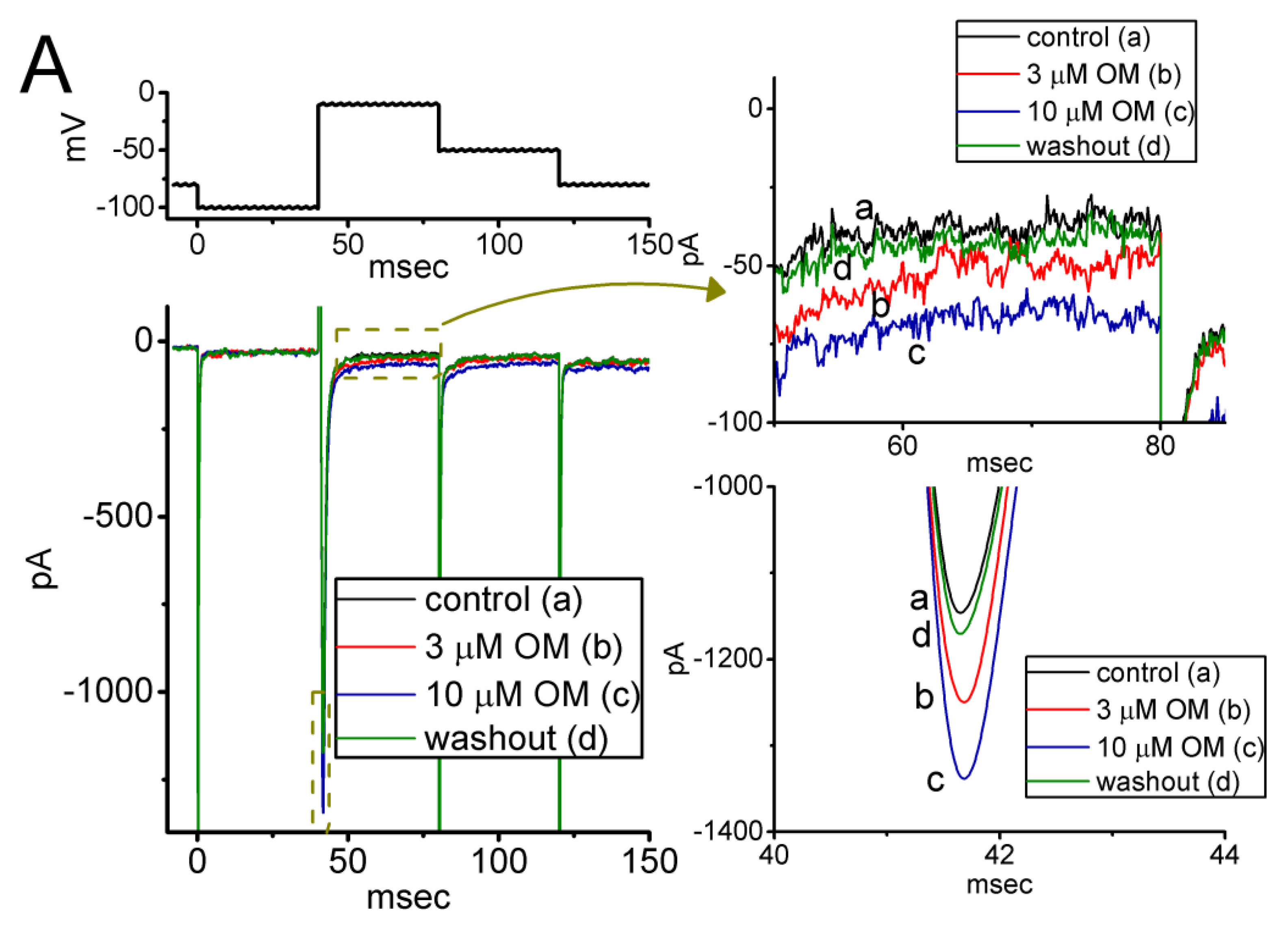
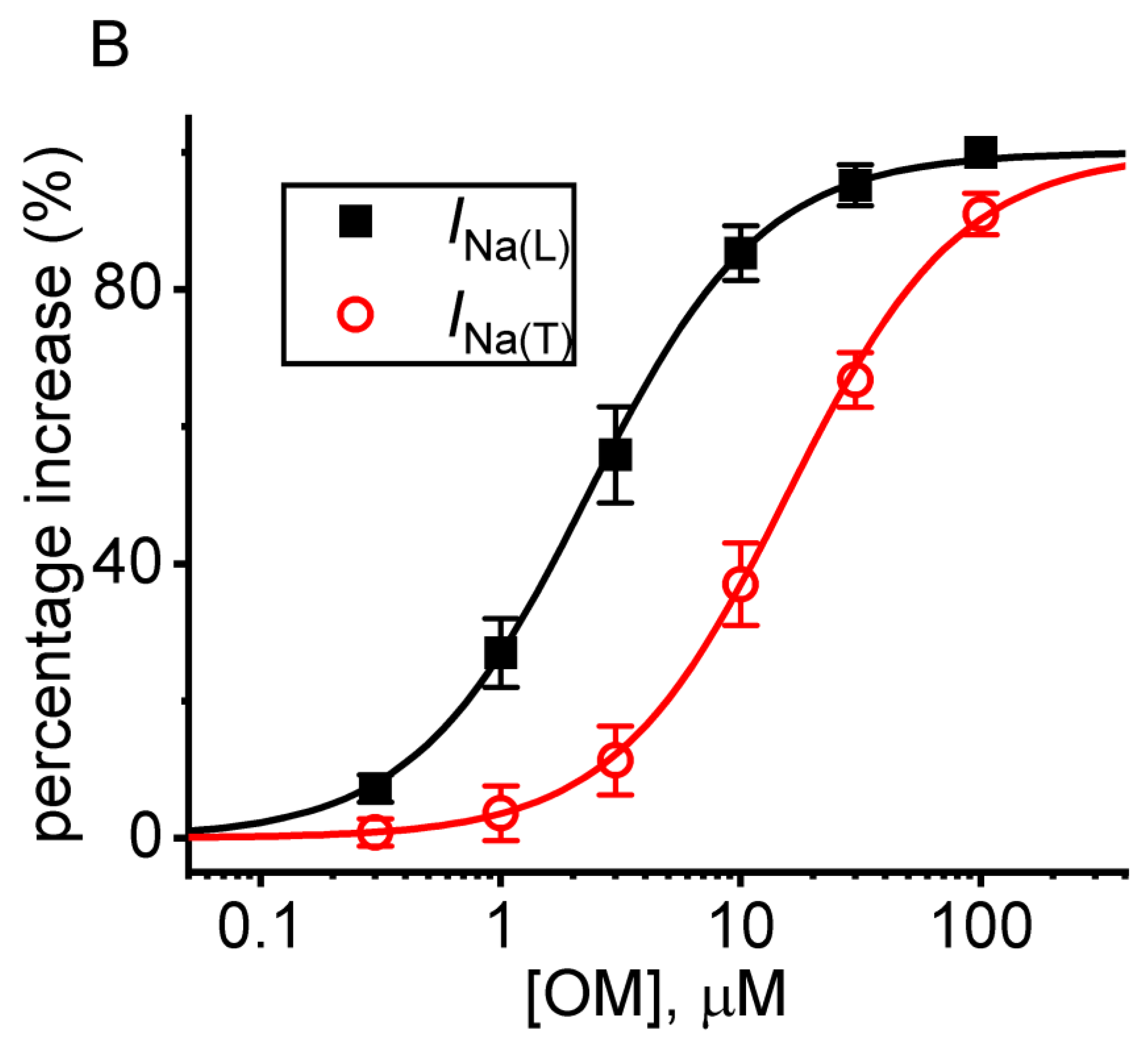
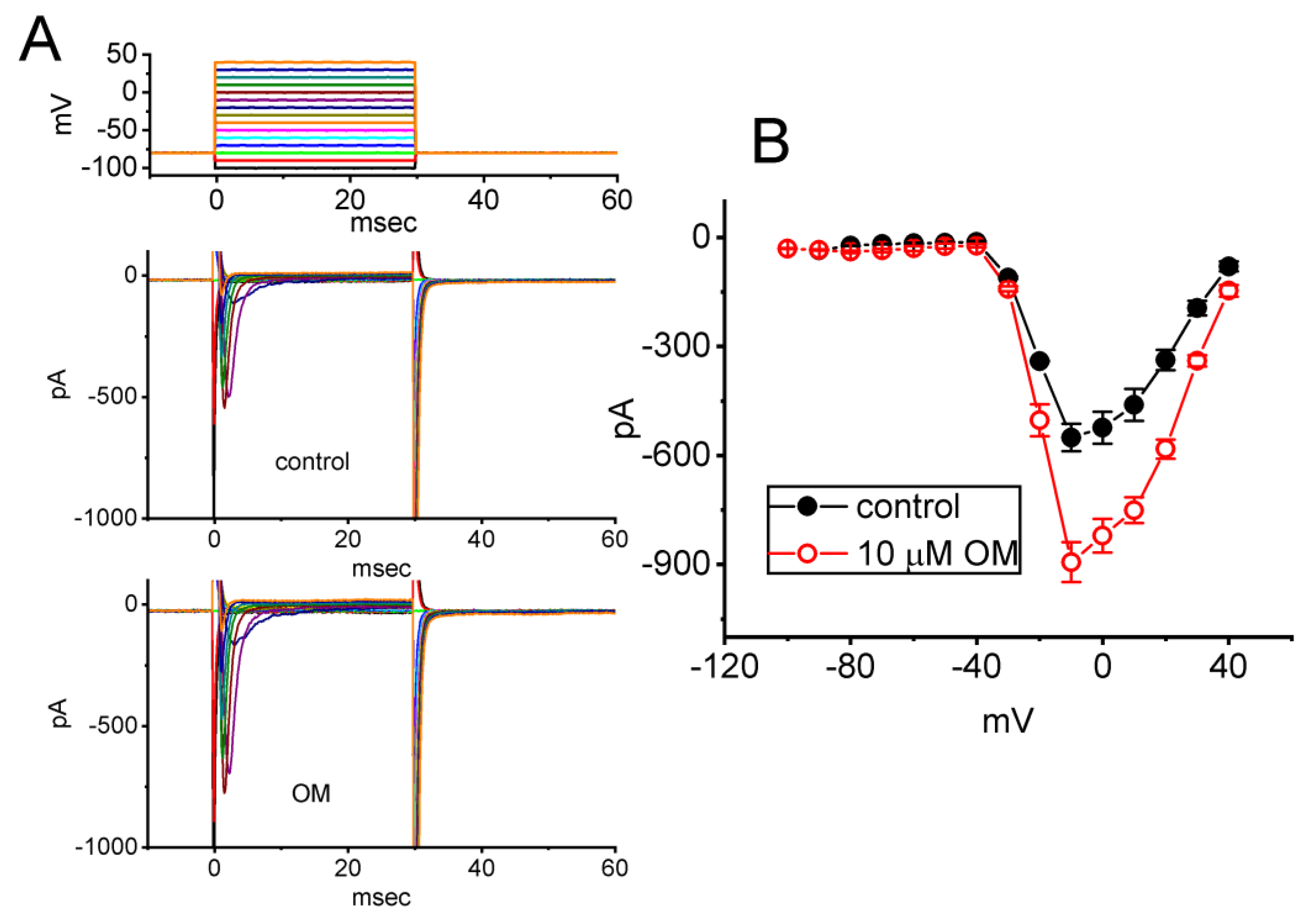
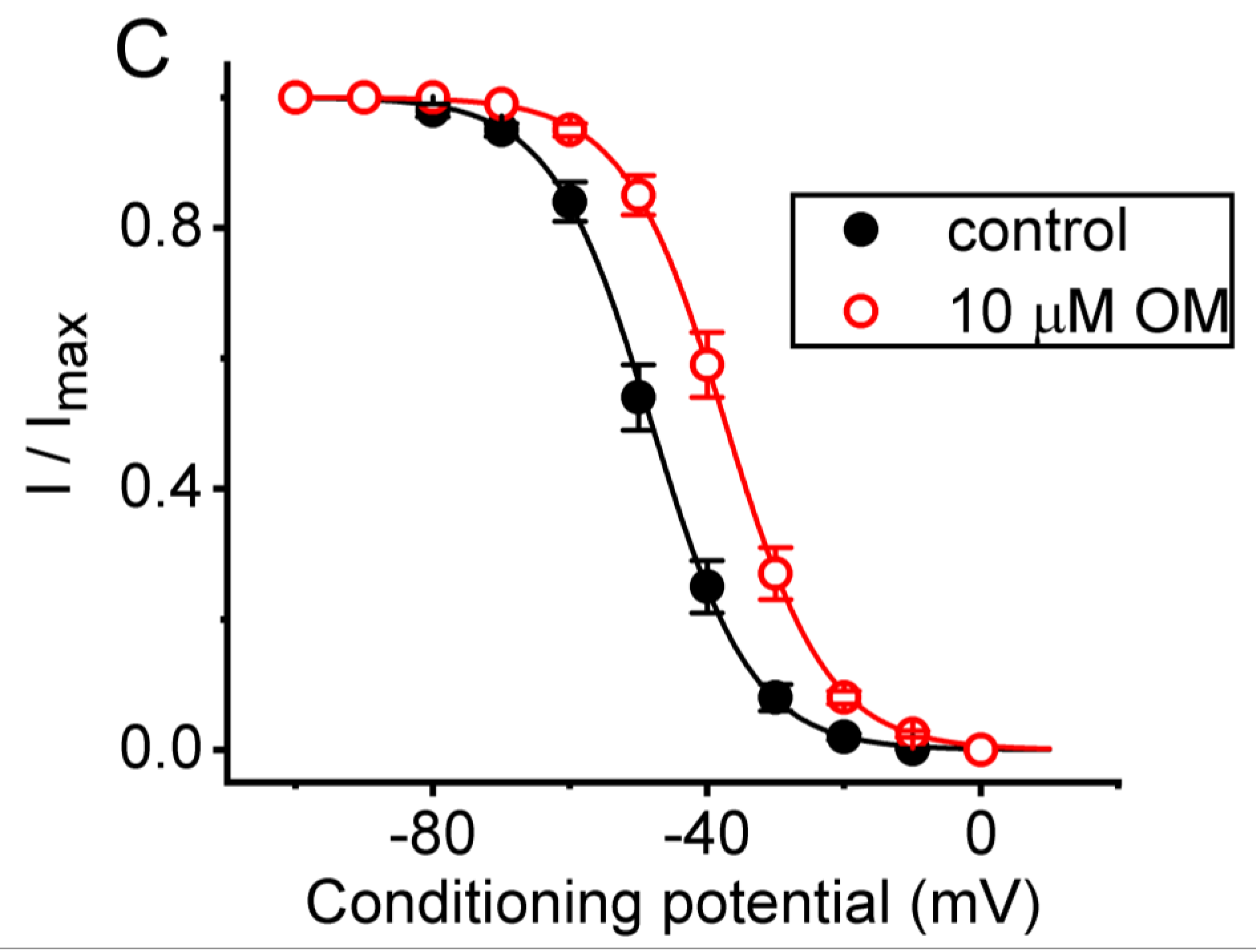
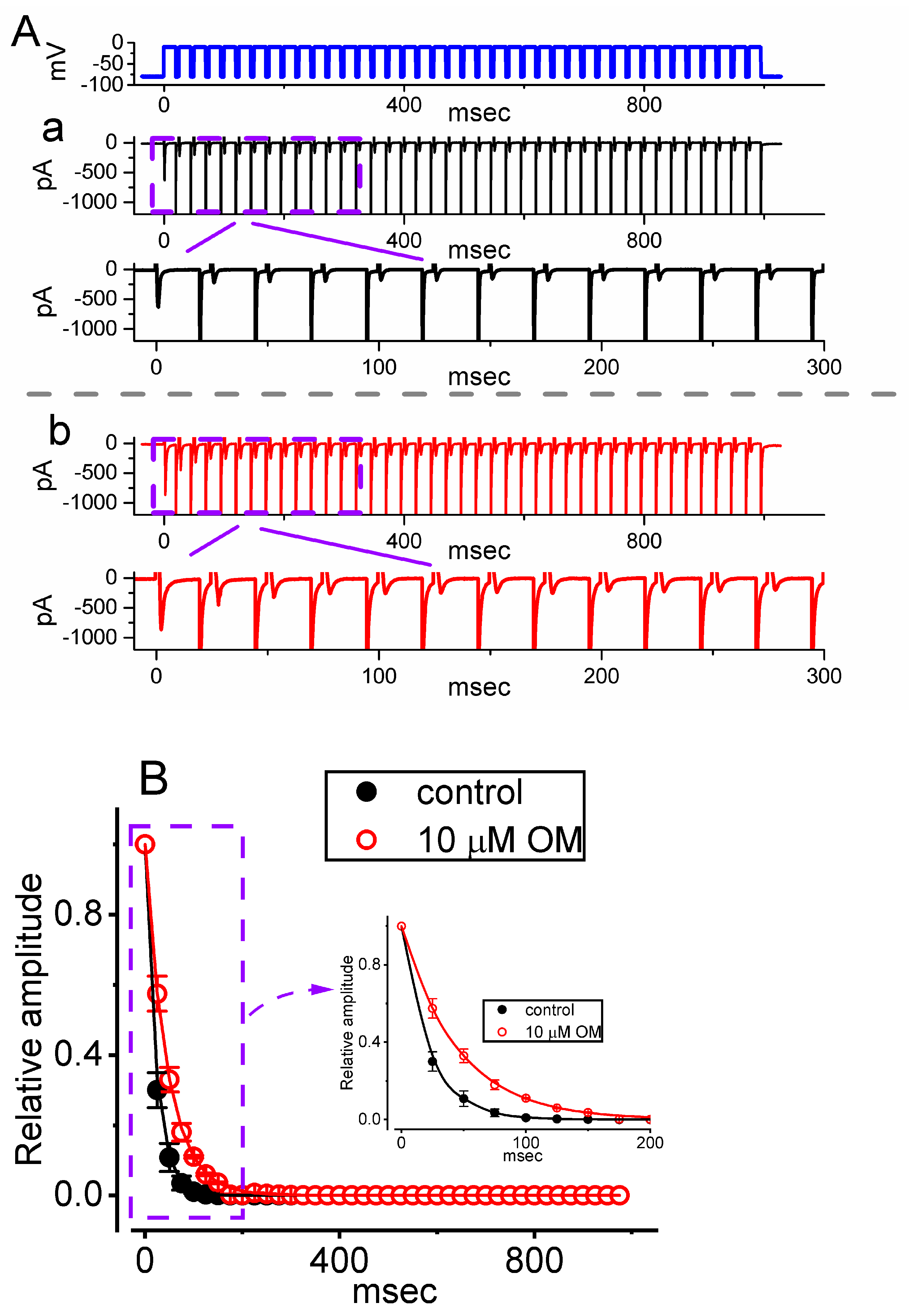
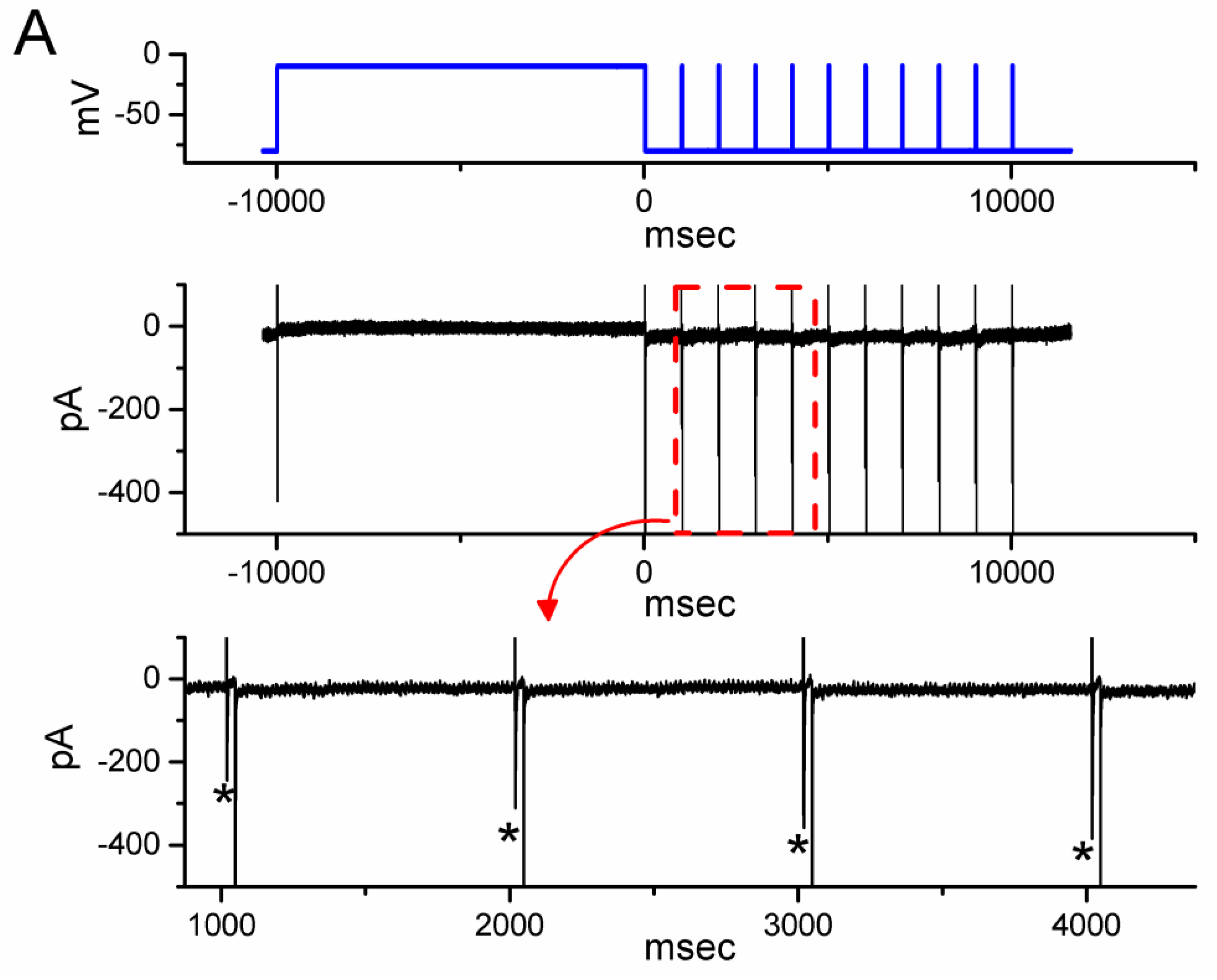
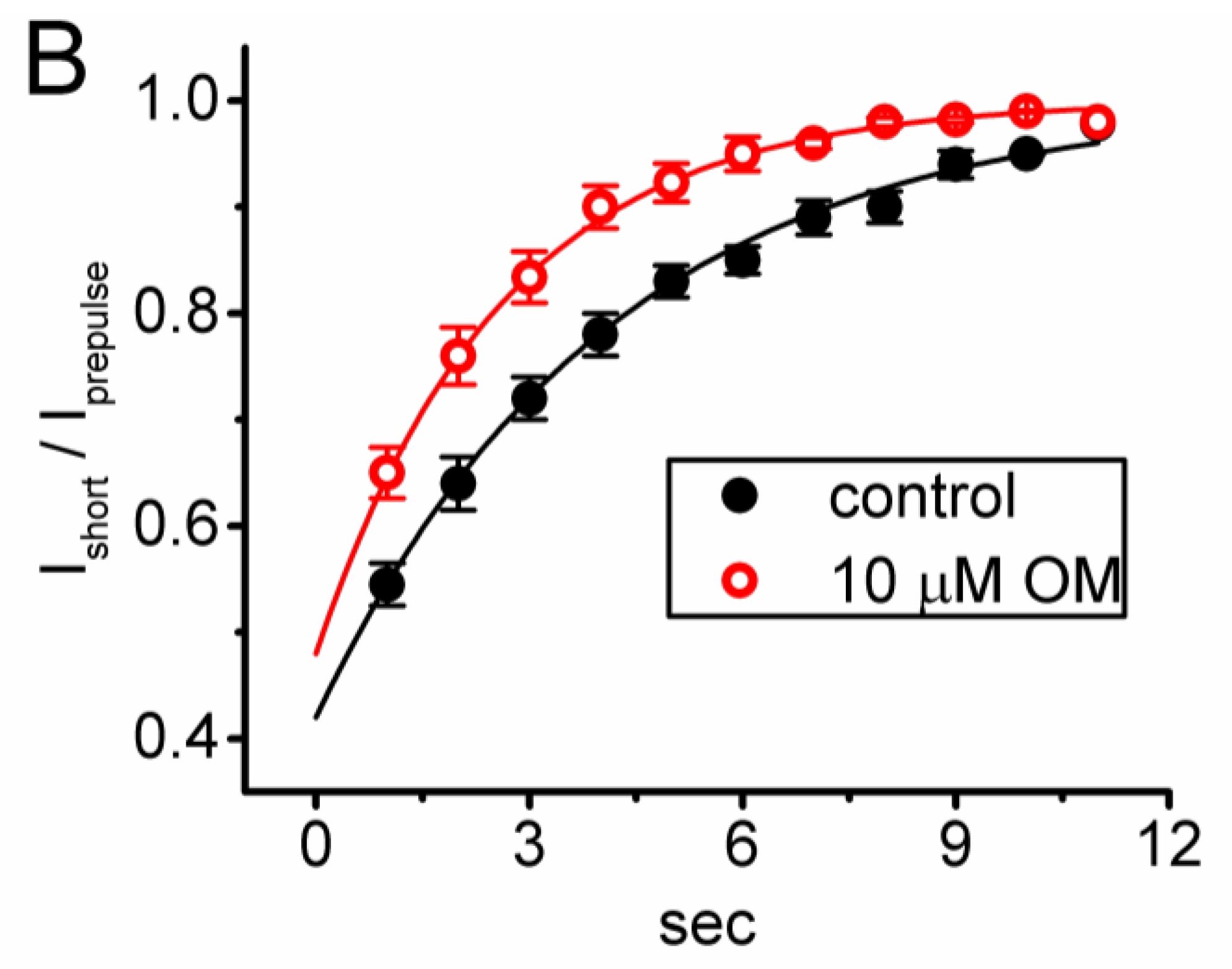
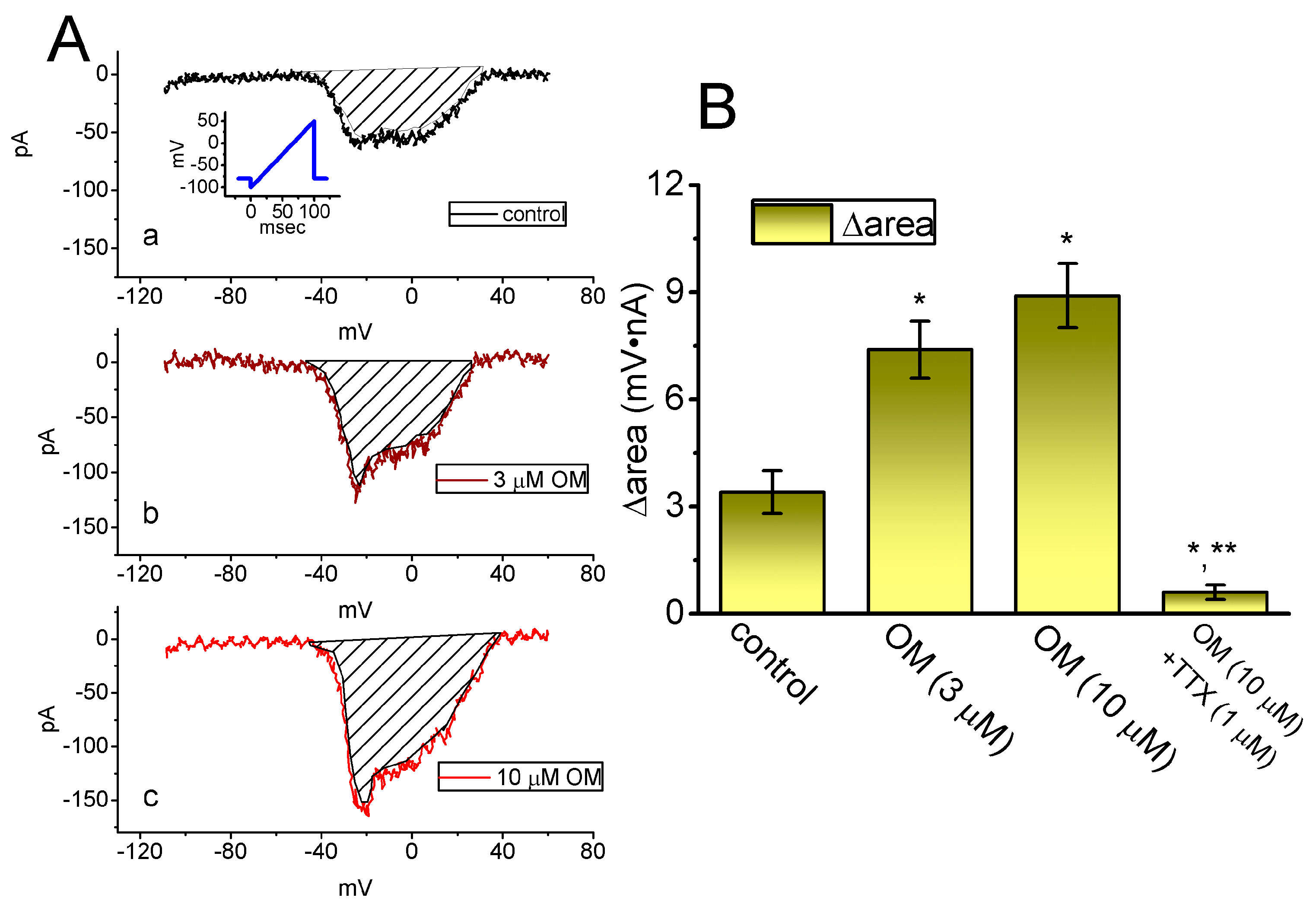

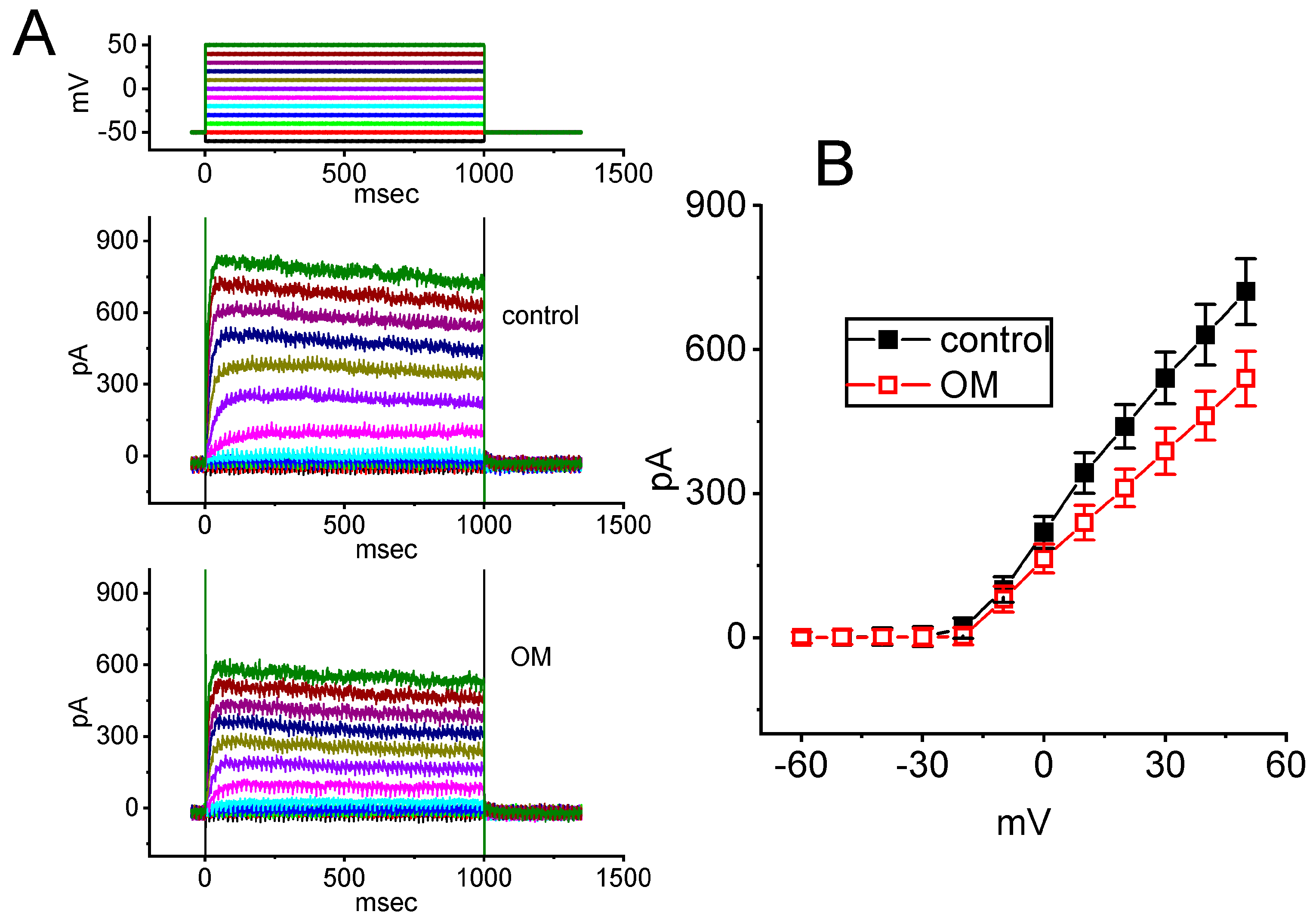
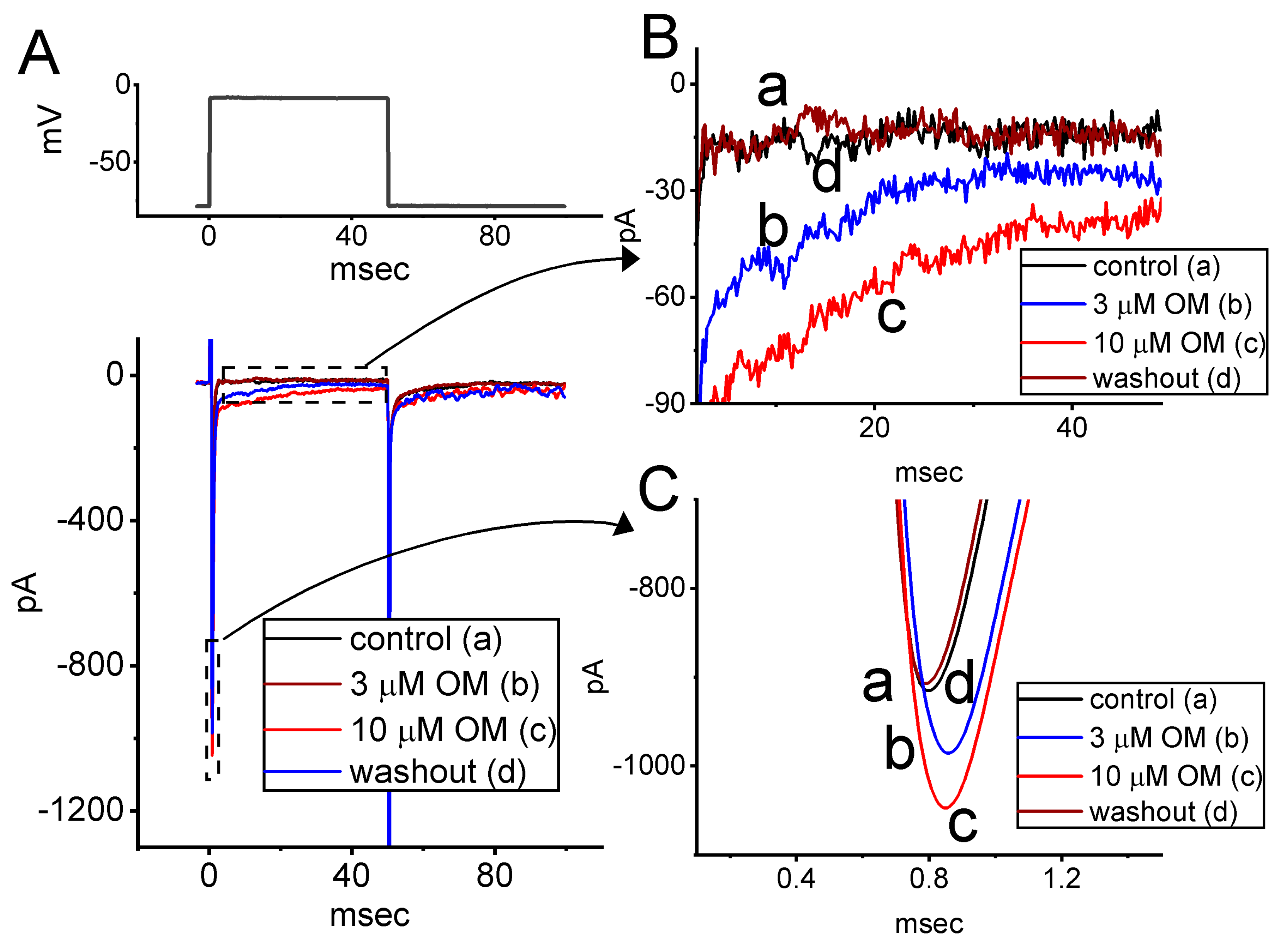
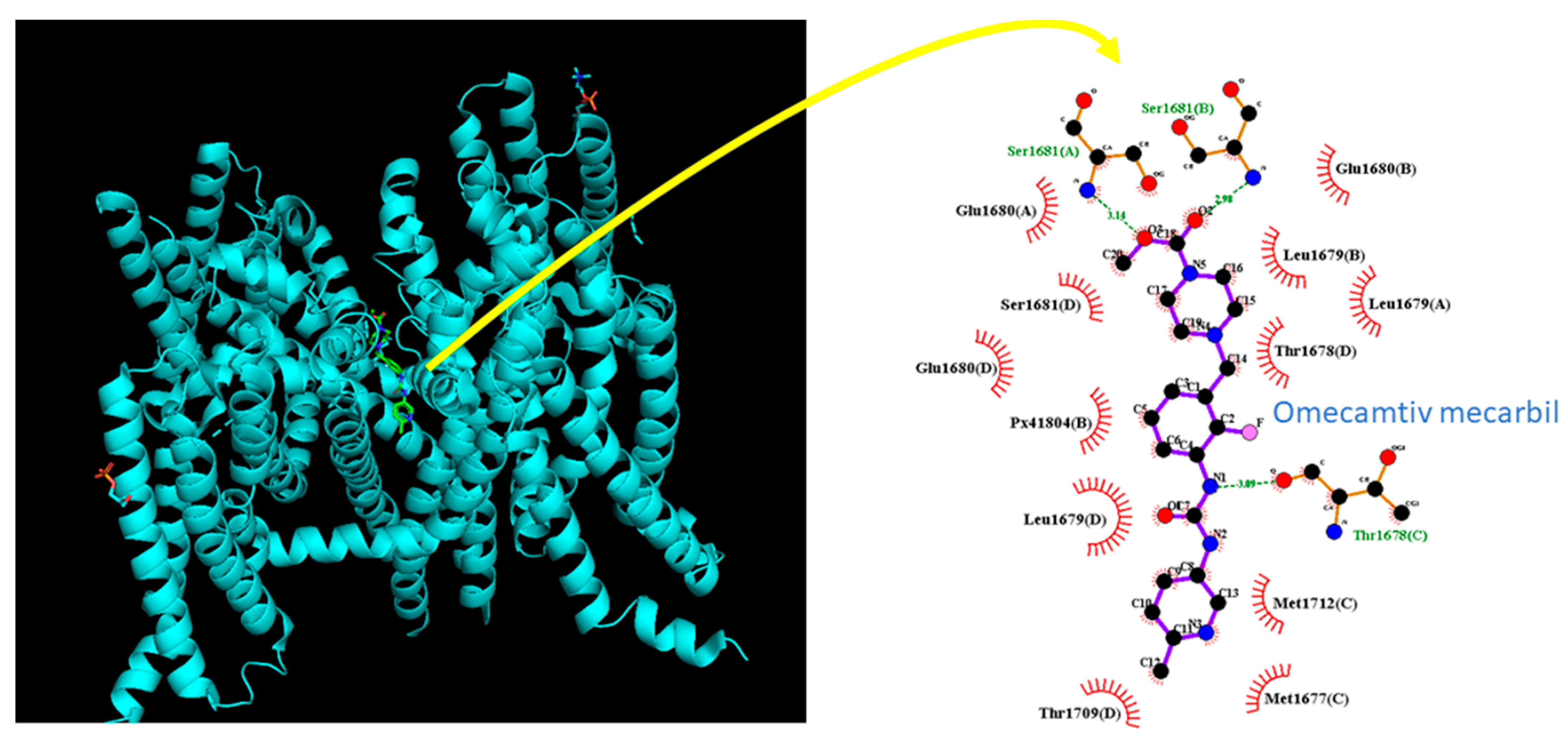
Disclaimer/Publisher’s Note: The statements, opinions and data contained in all publications are solely those of the individual author(s) and contributor(s) and not of MDPI and/or the editor(s). MDPI and/or the editor(s) disclaim responsibility for any injury to people or property resulting from any ideas, methods, instructions or products referred to in the content. |
© 2023 by the authors. Licensee MDPI, Basel, Switzerland. This article is an open access article distributed under the terms and conditions of the Creative Commons Attribution (CC BY) license (https://creativecommons.org/licenses/by/4.0/).
Share and Cite
Ting, C.-Y.; Shih, C.-L.; Yu, M.-C.; Wu, C.-L.; Wu, S.-N. Characterization of Stimulatory Action on Voltage-Gated Na+ Currents Caused by Omecamtiv Mecarbil, Known to Be a Myosin Activator. Biomedicines 2023, 11, 1351. https://doi.org/10.3390/biomedicines11051351
Ting C-Y, Shih C-L, Yu M-C, Wu C-L, Wu S-N. Characterization of Stimulatory Action on Voltage-Gated Na+ Currents Caused by Omecamtiv Mecarbil, Known to Be a Myosin Activator. Biomedicines. 2023; 11(5):1351. https://doi.org/10.3390/biomedicines11051351
Chicago/Turabian StyleTing, Chih-Yu, Chia-Lung Shih, Meng-Cheng Yu, Chao-Liang Wu, and Sheng-Nan Wu. 2023. "Characterization of Stimulatory Action on Voltage-Gated Na+ Currents Caused by Omecamtiv Mecarbil, Known to Be a Myosin Activator" Biomedicines 11, no. 5: 1351. https://doi.org/10.3390/biomedicines11051351
APA StyleTing, C.-Y., Shih, C.-L., Yu, M.-C., Wu, C.-L., & Wu, S.-N. (2023). Characterization of Stimulatory Action on Voltage-Gated Na+ Currents Caused by Omecamtiv Mecarbil, Known to Be a Myosin Activator. Biomedicines, 11(5), 1351. https://doi.org/10.3390/biomedicines11051351




